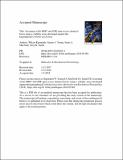Files in this item
Screening of the MMV and GSK open access chemical boxes using a viability assay developed against the kinetoplastid Crithidia fasciculata
Item metadata
| dc.contributor.author | Kipandula, Wakisa | |
| dc.contributor.author | Young, Simon A. | |
| dc.contributor.author | MacNeill, Stuart A. | |
| dc.contributor.author | Smith, Terry K. | |
| dc.date.accessioned | 2019-05-17T23:38:09Z | |
| dc.date.available | 2019-05-17T23:38:09Z | |
| dc.date.issued | 2018-06 | |
| dc.identifier | 253137217 | |
| dc.identifier | 7520813d-9f9a-41ad-9b3a-c2061d0c190a | |
| dc.identifier | 85047644620 | |
| dc.identifier | 000436219900009 | |
| dc.identifier.citation | Kipandula , W , Young , S A , MacNeill , S A & Smith , T K 2018 , ' Screening of the MMV and GSK open access chemical boxes using a viability assay developed against the kinetoplastid Crithidia fasciculata ' , Molecular and Biochemical Parasitology , vol. 222 , pp. 61-69 . https://doi.org/10.1016/j.molbiopara.2018.05.001 | en |
| dc.identifier.issn | 0166-6851 | |
| dc.identifier.other | RIS: urn:05B3F59AA64C5DD80E301E52F62D4D1E | |
| dc.identifier.other | ORCID: /0000-0003-1072-905X/work/45160471 | |
| dc.identifier.other | ORCID: /0000-0002-0555-0007/work/45160472 | |
| dc.identifier.uri | https://hdl.handle.net/10023/17726 | |
| dc.description | This work was supported through the Global Health Implementation program at the University of St Andrews by the Gloag Foundation and the Western Union Foundation. | en |
| dc.description.abstract | Diseases caused by the pathogenic kinetoplastids continue to incapacitate and kill hundreds of thousands of people annually throughout the tropics and sub-tropics. Unfortunately, in the countries where these neglected diseases occur, financial obstacles to drug discovery and technical limitations associated with biochemical studies impede the development of new, safe, easy to administer and effective drugs. Here we report the development and optimisation of a Crithidia fasciculata resazurin viability assay, which is subsequently used for screening and identification of anti-crithidial compounds in the MMV and GSK open access chemical boxes. The screening assay had an average Z’ factor of 0.7 and tolerated a maximum dimethyl sulfoxide concentration of up to 0.5%. We identified from multiple chemical boxes two compound series exhibiting nanomolar potency against C. fasciculata, one centred around a 5-nitrofuran-2-yl scaffold, a well-known moiety in several existing anti-infectives, and another involving a 2-(pyridin-2-yl) pyrimidin-4-amine scaffold which seems to have pan-kinetoplastid activity. This work facilitates the future use of C. fasciculata as a non-pathogenic and inexpensive biological resource to identify mode of action/protein target(s) of potentially pan-trypanocidal potent compounds. This knowledge will aid in the development of new treatments for African sleeping sickness, Chagas disease and leishmaniasis. | |
| dc.format.extent | 9 | |
| dc.format.extent | 650410 | |
| dc.language.iso | eng | |
| dc.relation.ispartof | Molecular and Biochemical Parasitology | en |
| dc.subject | Crithidia fasciculata | en |
| dc.subject | Kinetoplastid | en |
| dc.subject | Drug discovery | en |
| dc.subject | QH301 Biology | en |
| dc.subject | RM Therapeutics. Pharmacology | en |
| dc.subject | RA0421 Public health. Hygiene. Preventive Medicine | en |
| dc.subject | NDAS | en |
| dc.subject | SDG 3 - Good Health and Well-being | en |
| dc.subject.lcc | QH301 | en |
| dc.subject.lcc | RM | en |
| dc.subject.lcc | RA0421 | en |
| dc.title | Screening of the MMV and GSK open access chemical boxes using a viability assay developed against the kinetoplastid Crithidia fasciculata | en |
| dc.type | Journal article | en |
| dc.contributor.institution | University of St Andrews. School of Biology | en |
| dc.contributor.institution | University of St Andrews. Biomedical Sciences Research Complex | en |
| dc.identifier.doi | 10.1016/j.molbiopara.2018.05.001 | |
| dc.description.status | Peer reviewed | en |
| dc.date.embargoedUntil | 2019-05-18 |
This item appears in the following Collection(s)
Items in the St Andrews Research Repository are protected by copyright, with all rights reserved, unless otherwise indicated.

